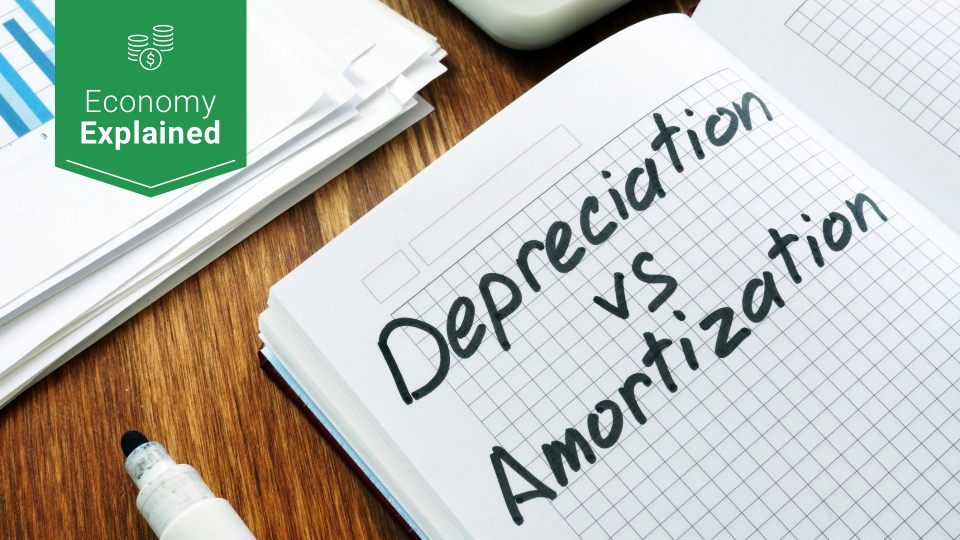Depreciation and Amortization: Know the Differences and Why They Matter to You

If you own a vehicle, you probably know “depreciation” as that evil force that makes your car start losing value the moment you drive it off the lot. If you have a mortgage — or any other loan, for that matter — you probably associate “amortization” with the payment schedule for the loan’s principal and interest.
GOBankingRates’ Best Credit Cards: See the Top Cards and Get Helpful Tips
The Economy and Your Money: All You Need To Know
But both words have alternate definitions that are important to business owners come tax time. If you’re thinking of starting a business — even if it’s a part-time side hustle — you’ll want to get to know these words all over again. That’s because they represent the primary ways of expensing your assets to lower your tax bills — and smaller tax bills are good for business.
More Economy Explained: What Is Inflation and What Does It Mean When It Goes Up or Down?
How Do You Expense Assets? Well, That Depends on the Asset
The IRS allows businesses to deduct a portion of many of their operating expenses — including their assets — which reduces their taxable revenue and lowers their tax obligation. When a company spends money to acquire assets that are necessary to its operation, it can expense those assets through either the process of amortization or depreciation.
So, how do you know which method to use? Well, if you can see and touch the assets, you should use depreciation. If you can’t, then amortization it is.
See: How Interest Rates Affect Your Wallet and the Bigger Economic Picture
Use Depreciation To Expense Tangible Assets
The IRS defines depreciation, which is used to expense tangible assets, as “an income tax deduction that allows a taxpayer to recover the cost or other basis of certain property. It is an annual allowance for the wear and tear, deterioration, or obsolescence of the property.”
Tangible assets are physical objects like an oven in a restaurant or styling chairs in a salon. In fact, just about any tangible asset that is necessary to the business’ operation can be depreciated, including:
Equipment
Machinery
Buildings
Furniture
Vehicles
Find Out: Understanding the Differences Between Inflation, Deflation & Stagflation
How Do I Know If My Business’ Assets Qualify?
In some cases, properties can receive a depreciation deduction, but they have to meet several criteria outlined by the IRS. Land can never be depreciated.
In order for all other tangible assets to be eligible for depreciation:
You have to own the asset.
You must use the asset as part of your business.
The asset has to have an expected life of more than one year.
The asset has to have a “determinable useful life.”
Helpful: How To Calculate Your Debt-to-Income Ratio
Expense Intangible Assets With Amortization
Intangible assets are assets that a business paid to acquire and that are necessary to the business’ operations, but that aren’t physical items. They include things like:
Patents
Copyrights
Research
Analyses, surveys and other startup costs
Franchise agreements
Like depreciation, amortization involves writing off an asset’s initial cost over the course of the asset’s useful life. In this case, the asset’s value is divided equally by the number of years the business will own it.
For example, let’s say a business spends $7,000 to secure a patent and the patent is good for seven years. Amortized over the life of the patent, the patent loses $1,000 in value every year. $1,000, then, is the amount that can be deducted annually.
Learn: Why Inflation’s 6% Cost-of-Living Increase to Social Security Could Be a Double-Edged Sword
Understanding the Straight-Line Basis
The method of dividing an asset’s value evenly over its lifespan is called the straight-line basis, which is almost always the process used to calculate amortization. The straight-line basis is sometimes, but not always, used to calculate depreciation, which is why the IRS states that “certain intangible property, such as patents, copyrights, and computer software is depreciable.” The difference is that tangible assets have what’s called a salvage value, like a car stripped for its parts. Intangible assets do not.
More From GOBankingRates
Fourth Stimulus Checks Are Coming From These States — Is Yours on the List?
Here’s How Much You Need To Earn To Be ‘Rich’ in 23 Major Countries Around the World
Last updated: Oct. 19, 2021
This article originally appeared on GOBankingRates.com: Depreciation and Amortization: Know the Differences and Why They Matter to You

 Yahoo Finance
Yahoo Finance 